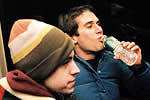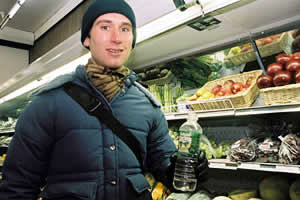 |

 |


Jon riding a trolley in Boston |
 |
He's changed his mailing address more often than he's changed his water bottle. When he moves, the bottle is the first thing he packs. Jon Cotner, a 26-year-old graduate student in philosophy, has refilled the same two water bottles for almost four years. "I don't want people to think I'm some kind of activist or something," he says. "I just don't see the point of paying for water."
We called Jon at his home in Santa Fe, and he was happy to answer some of our questions. Such as, does he wash the bottle? (The current bottle yes, the first one not really.) What do his friends think? (Occasionally nauseated but they respect his dedication.) Most of all, how does he handle the awkwardness of carrying a water bottle around everywhere? "How you hold the bottle makes a big difference," he explains. Jon holds the bottle by the base, with the top pointing towards the ground. "I don't know if you've ever walked long distances with a water bottle, but it's much easier. The water doesn't slosh around...after a while you hardly know it's there."
Carrying a bottle when its empty is even more challenging. "Most people throw the bottle away — they see it as a piece of garbage," he says. "That's when a change of perspective is necessary. You have to see the bottle not as a piece of garbage, but as a piece of equipment. It's just as much a part of my kitchen as a glass. It's as much a part of my camping equipment as a flashlight. It's gained permanence."
| DID YOU KNOW? Bottling and shipping water is the least efficient method of
water delivery ever invented. The energy we waste using bottled water would
be enough to power 190,000 homes. But refilling your water bottle from the
tap requires no expenditure of energy, and zero waste of resources. Watch our related story, Bottle This! |  |  |
Even more awkward than carrying the bottle, is explaining it to others. "Looking at Jon's bottle," says his friend Andy Fitch, "is like looking at a friend's messy bedroom." On a hike with his ex-girlfriend, his refusal to pay for a new water bottle led to a break-up of the relationship. "I know a lot of people think it's weird," says his friend Johanna in his defense. "But when you think about it, it's even weirder that society thinks it's weird."
This story began as a profile of someone who simply would not pay for water. It turned into a meditation on disposable objects, and the surprising things that can happen when we preserve that which was meant to be thrown away.
Watch and listen to a slideshow about Jon

We want to hear your thoughts on the issues. Do you reuse disposable items? Are you willing to pay more for water in a bottle? Share your story with us, and see what others have to say.
|
 |
 |
|
 |


 (Requires Flash) (Requires Flash)

Call him the Galileo of the Refill-Your-Water-Bottle
movement. Jon Cotner, of Santa Fe, New Mexico, believes plastic water bottles
should be re-used. Friends think it's gross. Ex-girlfriends think he's stubborn.
But
Jon
knows that somehow, somewhere, the right person will understand — and love — the
boy behind the
faded plastic. (8:35 minutes)
|
|
 |
 |
|
 |


In 2002, approximately 31% of soda bottles were recycled, while only 11% of water bottles were. Why? The reason, says Jennifer Gitlitz, research director for the Container Recycling Institute, is that few states require a deposit on water bottles. Even in the ten states that have so-called "bottle bills," requiring a 2-10 cent deposit on bottles and cans, most of those bills exclude non-carbonated beverages.
"At the time those bills were written, the bottled water industry hardly existed," says
Gitlitz. Since bottled water is now the second most popular beverage in the country,
and since plastic water bottles are made of the same PET plastic that soda bottles
are made of, she says it's time for an update to the law. So far, only Maine
and California have updated their bottle bills to put a deposit on water bottles.
New York may be next. A broad coalition of environmental, civic, labor, religious,
and farming groups is campaigning to
update New York's bottle bill.
|
|

|
|
